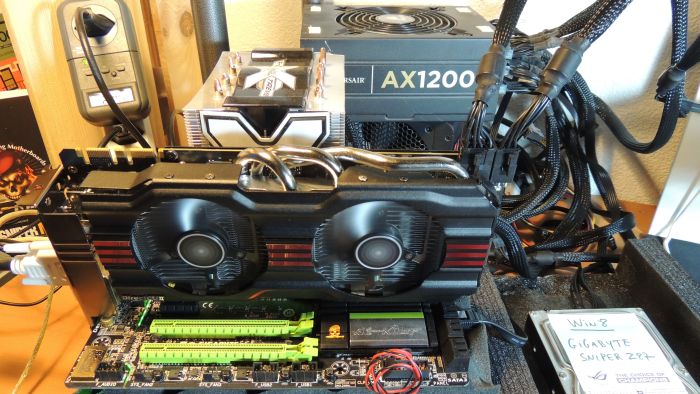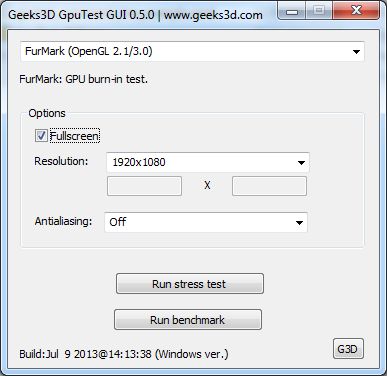Article index:
- 1 – ASUS GTX 770 DC2 OC Gallery
- 2 – ASUS GTX 770 DC2 OC GPU Data
- 3 – ASUS GTX 770 DC2 OC Benchmarks
- 4 – ASUS GTX 770 DC2 OC Burn-in Test
3 – ASUS GTX 770 DC2 OC Benchmarks
The GTX 770 is based on a refresh version of the GTX 680 GPU. So let’s see what the GTX 770 brings compared to the
GTX 680 and why not, let’s add a GTX 780 in the battle.
For this battle, I used GpuTest 0.5.0, Unigine Heaven 4.0 / Valley 1.0 and 3DMark. All cards have been benchmarked with stock clock speeds and default power/temperature targets.
For all tests, the GTX 680 is the reference card for the scores (100%).
The testbed:
– PSU: Corsair AX 1200
– Motherboard: Gigabyte G1.Sniper M5
– CPU: Core i5 4670K @ 3.4GHz
– Memory: 4GB DDR3 Corsair
– Win8 Pro 64-bit
– Graphics drivers: R326.19

Settings for all GpuTest tests: 1920×1080 fullscreen, no AA, duration: 60 seconds.

3.1 – GpuTest: FurMark test
– Settings: 1920×1080 fullscreen, no AA
- GTX 680: 3010 points, 50 FPS
- GTX 770: 3306 points, 55 FPS (+10%)
- GTX 780: 5714 points, 95 FPS (+89%)
– Settings: 2560×1440 fullscreen, no AA
- GTX 680: 2137 points, 35 FPS
- GTX 770: 2316 points, 38 FPS (+8%)
- GTX 780: 3756 points, 62 FPS (+75%)

3.2 – GpuTest: TessMark test
The TessMark test with a tessellation level of 32 have been used:
- GTX 680: 26321 points, 438 FPS
- GTX 770: 29558 points, 492 FPS (+12%)
- GTX 780: 33799 points, 563 FPS (+28%)

3.3 – GpuTest: GiMark test
- GTX 680: 5484 points, 92 FPS
- GTX 770: 5812 points, 96 FPS (+6%)
- GTX 780: 7510 points, 124 FPS (+36%)

3.4 – GpuTest: Piano test
- GTX 680: 847 points, 14 FPS
- GTX 770: 916 points, 15 FPS (+8%)
- GTX 780: 1091 points, 18 FPS (+28%)

3.5 – GpuTest: Volplosion test
- GTX 680: 1970 points, 32 FPS
- GTX 770: 2078 points, 34 FPS (+5%)
- GTX 780: 2503 points, 41 FPS (+27%)

3.6 – GpuTest: Plot3D test
- GTX 680: 62841 points, 1047 FPS
- GTX 770: 66585 points, 1109 FPS (+6%)
- GTX 780: 63403 points, 1055 FPS (+1%)

3.7 – GpuTest: Triangle test
- GTX 680: 11259 FPS
- GTX 770: 10500 FPS (-7%)
- GTX 780: 12333 FPS (+9%)

3.8 – Unigine Heaven 4.0
Settings: Direct3D 11, 1920×1080 fullscreen, AA: 8XMSAA, quality: ultra, tessellation: extreme
- GTX 680: FPS: 35.6, Score: 896
- GTX 770: FPS: 37.8, Score: 953 (+6%)
- GTX 780: FPS: 49.4, Score: 1245 (+38%)
3.9 – Unigine Valley 1.0
Settings: extreme HD
- GTX 680: FPS: 42.5, Score: 1780
- GTX 770: FPS: 46.4, Score: 1941 (+9%)
- GTX 780: FPS: 56.4, Score: 2358 (+32%)
3.10 – 3DMark11
- GTX 680: X3305
- GTX 770: X3595 (+9%)
- GTX 780: X4348 (+31%)
3.11 – 3DMark FireStrike
– Settings: normal (1920×1080 fullscreen)
- GTX 680: 6032
- GTX 770: 6499 (+8%)
- GTX 780: 7996 (+32%)
– Settings: Extreme (2560×1440 fullscreen)
- GTX 680: 3046
- GTX 770: 3319 (+9%)
- GTX 780: 4212 (+38%)
3.12 – FluidMark 1.5.2
– Settings: preset 1080 (1920×1080 fullscreen, 7 emitters, 60’000 particles)
- GTX 680: 3706 points, 61 FPS
- GTX 770: 3888 points, 64 FPS (+5%)
- GTX 780: 4622 points, 76 FPS (+25%)
3.13 – Analysis
The GTX 770 DC2 OC is around 10% faster than the GTX 680 reference board. This is essentially caused by higher clock speeds (GPU core and memory) and by a better power management (GPU Boost 2.0): higher TDP and higher voltages. The GTX 770 is a super GTX 680! The GTX 770 is around 20% slower than the GTX 780.
Article index:
- 1 – ASUS GTX 770 DC2 OC Gallery
- 2 – ASUS GTX 770 DC2 OC GPU Data
- 3 – ASUS GTX 770 DC2 OC Benchmarks
- 4 – ASUS GTX 770 DC2 OC Burn-in Test